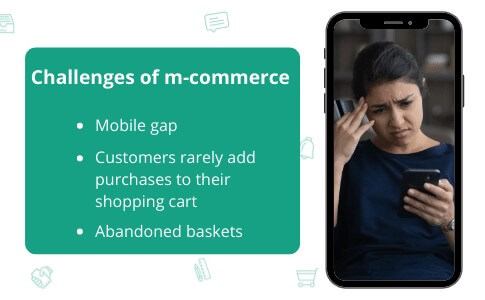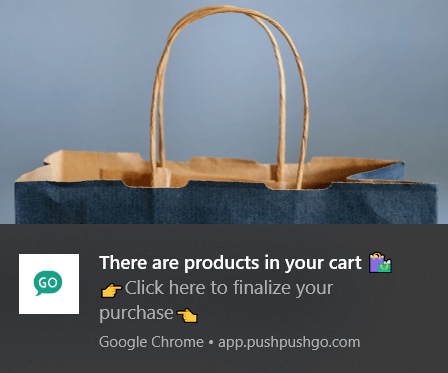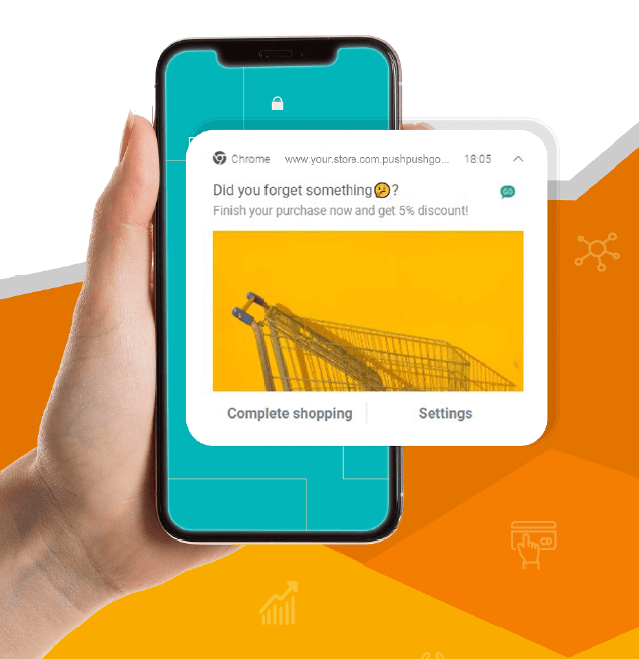What is m-commerce and what are the sales opportunities it creates?


What is m-commerce and what are the sales opportunities it creates?


According to Kibo Monetate, in Q3 2020 conversion rate for desktops was 2,59%, while for mobile devices 1,86%. Even though the difference between average conversion rate on desktop and mobile decrease year over year, the difference in average order value (AOV) is still significant. AOV for mobile in Q3 2020 was USD 84,69 and for desktop purchases - USD 120,51.
However, there is a growing number of users who don't wait until they get home to log on to their computer to buy something they thought of while walking or riding the bus home. They just take out their phone and make the transaction with a few clicks.
Such customers are a treasure for companies because they do not postpone the decision to buy and are ready to act very quickly. However, in order to have such customers, the company has to work hard to create a space that will encourage people to make purchases using their phones.
In this article, we will discuss what m-commerce, or sales through mobile devices, is and how it differs from e-commerce. We will also tell you how retailers can encourage smartphone and tablet users to use these devices not only to browse the store's offer but also to make purchases.
M-commerce: definition
Selling from the level of any mobile device (smartphone or tablet, less often an e-book reader) is mobile commerce otherwise known as m-commerce.
However, this concept is much broader and includes not only making purchases, but also all activities related to the consumer's online shopping activity: subscriptions, payments, mobile banking.
M-commerce VS e-commerce
M-commerce grew out of e-commerce, or electronic commerce. It can be said to be the result of technological development and the changing world of digital services. E-commerce includes online stores, but also online currency exchange, online banking, online betting.
Transfer of trade to the network is not a new phenomenon. For a few years already, retail chains have been developing e-stores simultaneously with stationary stores, because they know that they have to base their business on two "legs". This is confirmed by the numbers.
According to Statista, global e-commerce sales surpassed USD 4,23 tr. In addition, according to Adobe Analytics in Q1 2021 YoY growth was 38% and the market will continue to grow.
Since more and more users access the Internet via smartphones, e-commerce sales are moving from desktops to mobile. This has led to the emergence of the m-commerce category. And it is by no means a marginal phenomenon.
M-commerce - 5 important statistics
- In 2021 there are globally 2,14 bln digital buyers (Statista), which is 900 mln more than it was in 2020. And it is expected that by the end of 2021 the share of mobile commerce in all e-commerce will rise to 72,9%.
- The results look different in the youngest group of respondents: users aged 15-24 definitely shop online most often using a smartphone (Gemius). This option was chosen by as many as 92% of respondents.
- The growth rate of mobile commerce is 29%, while for e-commerce the average growth rate is 22% globally (Statista).
- Mobile shopping stands out by its short decision-making process. About 70% of mobile searches lead to action during one hour (Forbes). In comparison, for desktop shoppers, the decision process in average takes about a month.
- The abandonment cart rate for mobile shopping is 85,65%, in comparison to 80,74% for tablets and 73% for desktops (Barilliance).
Types of m-commerce
As we have already mentioned, m-commerce encompasses a wide range of activities that are carried out through mobile devices. M-commerce is such a new phenomenon that it has not yet seen many publications in which the authors have made a clear distinction between the types of m-commerce.
Regardless, we can distinguish three major groups:
- Shopping
- Mobile banking
- Mobile Payments
These three categories are highly interconnected. After all, a customer won't buy goods with their phone if they don't have access to fast and secure payments. Fortunately, modern mobile wallets are solving the problem of paying by phone.
This is also a challenge for merchants who want to attract "m-customers": they should integrate wallets with the shopping app so that a customer can complete the entire transaction without leaving the app. This is not only about convenience and, as a result, a better experience, but also about the risk that if a customer leaves the app, he will give up shopping. Through a poorly designed shopping path, a store can lose a customer who has already practically finalized the purchase.
M-commerce: challenges

The mobile gap, or reasons for low conversions
Since more than half of online shoppers have bought something from their phone or tablet at least once, sellers cannot ignore this group of potential customers - especially since data proves that the share of m-commerce in e-commerce is growing. One of the challenges facing online sellers is how to increase m-commerce sales.
But let's rephrase that question and first consider why customers don't shop on mobile devices. We see this often on public transport: users have time, so they read news on news sites, use social media or browse online store offers. However, browsing the offer rarely results in making a purchase.
This phenomenon is called the mobile gap (Dynamic Yield). It is the difference between the amount of traffic to the website/shop coming from mobile devices and the value of revenues generated by these devices.
Why aren't users finalizing purchases via smartphones?
- It is more difficult to view a product on the small screen of a phone than on a laptop.
As a result, they treat the phone as a device to conduct an initial "review" of the store, but before they place an order, they want to view it on a laptop or computer. - They are afraid to make payments using the phone.
The reluctance to pay by phone may be a result of habit. Users are accustomed to regularly updating security and antivirus software on their laptops rather than their phones - and this gives them the belief that the laptop is better protected. In reality, it may be the same level of security.
It is in the sellers' interest to convince potential buyers that buying with a smartphone is safe and no unauthorized person will have access to their money. - Making payments is time-consuming and not very intuitive.
A customer who encounters difficulties in completing the transaction will most likely abandon this step. In the best case, he will leave the products in the shopping cart and complete the purchase after logging in to his laptop. In the worst case - he or she will never come back to shopping. It is in the interest of the site owner to design the site in such a way that it is intuitive and does not create additional barriers.
Customers rarely add purchases to their shopping cart
It is estimated that regardless of whether customers use laptops or smartphones, a similar percentage of them - about 70% - reaches the product card (i.e. a subpage containing detailed product information). This is good news for stores that want to attract customers from mobile.
There is also bad news: the add-to-cart conversion rate is 28% lower for mobile devices than it is for desktop devices.
We can attribute this result to the reasons already mentioned above for which customers do not treat mobile devices as a tool to make purchases, but only to get acquainted with the offer. To overcome them, retailers need to improve the m-site or app. How many changes will be needed? As many as needed. Since the group of users who are ready to buy via smartphone is growing every year, it is in the best interest of stores to create the conditions for them to do so.
When there is so little left to complete the purchase - abandoned shopping carts
Since the problem is that customers end their adventure with the online store after browsing products or add them to the cart, but without a guarantee that they will return to it from the computer, it is worth using tools that will remind them of unfinished transactions.
Web push will remind about unfinished purchases.

Web push notifications will be an ideal tool. They are small, rectangular messages that appear on the screen of a laptop or phone. The user, who has previously agreed to receive them, does not have to be on the store's website at the moment for the notification to take effect. This is what makes them superior to other channels of contact: they make the user receive information or a reminder from a site he or she may not have visited in recent days and had no intention of visiting.
With web push notifications you can inform subscribers about promotions, new goods in the categories they are interested in, remind about the products in their carts. For example, the average CTR for an e-commerce automation scenario for saving abandoned shopping carts is 8.32%.
On average, about 70% of subscribers in the e-commerce industry have signed up for notifications using their smartphones. This is an average for the entire market, as specific numbers will depend on the area in which the e-store operates.
This data shows the potential of this tool and it is definitely worth testing in your store.

Trends in m-commerce
The challenges faced by merchants who want to increase the share of m-commerce in their overall sales will diminish over time. Why this certainty? Because the role of smartphones in users' daily lives is strengthening so fast that in time a large group of unconvinced people will also want to use them while shopping. The role of retailers will be to meet them and offer applications that will allow them to shop quickly, conveniently and safely.
In the coming quarters (we are not talking about a perspective of years - in e-commerce, of which m-commerce is a part, changes happen much faster) we can expect new functions that will encourage customers to buy from mobile devices. These will include:
Better customer service. Stores will offer virtual assistants who will solve customer problems on the fly. Although chatbots have found a permanent place in e-shops, so far they have been shyly adopted by m-shops.
Streamlining the process of finalizing purchases. Simplifying order confirmation and payment is a key move to minimize the risk of "shopping cart abandonment" by customers. One-click technology will gain popularity so that customers do not have to manually complete purchase forms. The "one-click" system remembers the data entered on previous purchases while being secure enough to ensure it doesn't leak out.
First of all - security. Implementation of new, secure solutions costs money, but without it, you can forget about attracting new customers and keeping the existing ones. Users are increasingly sensitive to the dangers lurking in the network, regardless of the sales channel, so they expect the vendors to create solutions that make it as difficult as possible for fraudsters to operate.
Applications instead of mobile websites. With the help of applications, the store is able not only to offer additional options and services to customers but also to influence their actions more.
With good design, the user will want to check the news in the app on their own, so make it attractive. Let the app provide access to discounts, information about upcoming promotions, the opportunity to premiere the purchase of goods. It can also have a "knowledge zone" because this will encourage users who do not want to buy anything at the moment but are interested in learning some interesting facts about the industry in which the brand operates.
In conclusion
Mobile commerce is the future of e-commerce. This technology is still developing and certainly hasn't reached the final level. There's still a lot of work to be done on the service design side to make buying with a phone even faster, more intuitive and more secure.
The growing popularity of m-commerce is a challenge for retailers, who need to be aware that the world of commerce is constantly changing, and they need to be able to enable customers to shop the way they want. Those who take care of the mobile shoppers will gain loyal customers and be able to plan the future of their store with confidence.






